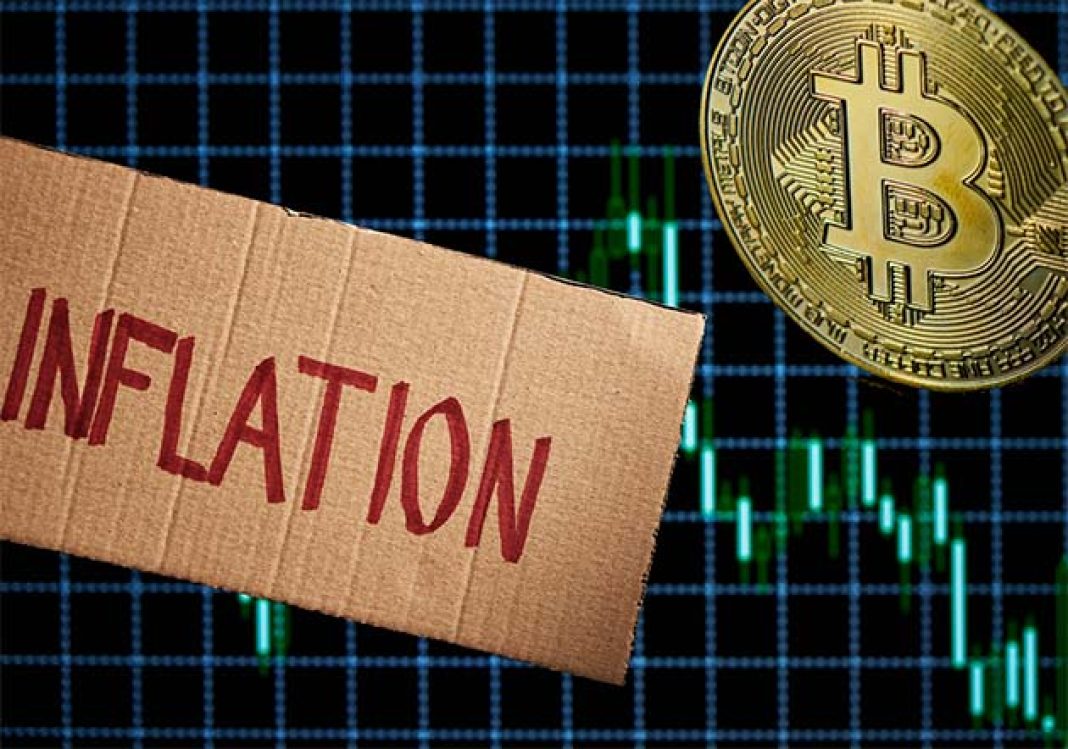The consumer price index in the US increased to 9.1 percent, the highest annual inflation rate in 40 years, due to enduring elements in housing and healthcare. The Fed continues to think that most inflation is temporary and that significant hikes of several percentage points are not expected. However, some, like Laurence Summers, think that the central bank has already lost credibility and that expectations will become irrevocably tainted if it does not act belligerently. If the Fed’s reputation is damaged, inflation will continue, and bitcoin will have a great chance to become a viable alternative.
Still jobs despite the recession
The current state of the American economy is perplexing. Even though a recession looks impending, job levels are constantly changing. In fact, the Fed will have a difficult time controlling inflation without sending the US economy into a recession. The Bloomberg consensus indicates that there is a 50% chance that the US will experience a recession.
The US GDP declined by 1.6% in the first quarter, and the second quarter appears to be even worse. Americans still spend money, but at a slower rate now than they were a few months ago. Thus, the populace is reducing its consumption as it starts to accept the rather long-lasting character of the price increase. In May, consumer spending as a whole increased by 0.2%. a factor that decreased from increase of 0.9% a month earlier.
Consumer spending has up until now been the main engine of the US economy, despite inflation rates that are nearly four decades high. Overall, US consumers are spending almost as much as they were previously, but more so to keep up with the trend of rising prices than to buy additional items.
Obviously less growth, but quite low unemployment compared to expectations.
Falling commodity prices
In terms of inflation rate, we notice a slowing of the inflationary dynamic. Supply networks are beginning to recover as commodity prices start to decline. Reduced production costs are a result of falling raw material prices, which impacts the ultimate cost of items. But overall inflation in the US increased once more in June, reaching an all-time high of 9.1 percent. We have reached the levels of monthly inflation seen in the 1970s. Terrifying.
While the price of some commodities began to decline a few months ago, the price of wheat and oil, the two commodities that Putin’s conflict has disturbed the most, has only recently begun to decline. Therefore, it’s possible that there is still a ton of room for price reductions (fingers crossed).
Everybody is anticipating the Fed.
The Fed will unavoidably need to take further action if inflation does not decline permanently despite the declines in the price of wheat and oil, the reduction of the budget deficit, and the lowering of monetary injections. Like Paul Vocker in his day, take additional steps to combat inflation. When we look at the history of US monetary policy and the observed amount of inflation, rate rises are still relatively modest.
Reduced budgetary spending
The level of savings remains constant when the government spends “too much” of the tax dollars, which increases the level of demand and encourages inflation. Due to $2 trillion in wasteful spending, the GDP artificially increased in one year but did not expand structurally. The first cause of price inflation is in reality these budgetary expenses. Budget deficit absent, no monetary injections. And there wouldn’t be a budget deficit without high budget expenses in relation to tax receipts.
There was undoubtedly a perception that the 2009 Obama stimulus was insufficient and that the current stimulus needed to be considerably more significant. When you inject 12 percent of the GDP as a stimulus, it frequently has unfavorable effects.
However, spending on this has generally decreased in recent months in the US. They even reach the levels seen prior to the covid epidemic when expressed as a percentage of GDP. Government revenue has increased at the same time. It is feasible to comprehend the weakening of the level of demand thanks to this two observations. Particularly considering that the Fed has increased its rates from 0.08 percent to 1.21 percent and that further increases are on the way. a negative impact on investment and consumption spending that came along with inflation.
Group of people who spend down their savings in the face of inflation
Americans’ pandemic-related savings have also been extensively used. Americans are spending the money they have saved as a result of stimulus measures and out of caution because the population’s savings rate is so low. The possibility of inflation is also diminished by the depletion of covid deposits.
a government with lower American tax expenditures. a central bank that uses less money to erode the value of the dollar. a reserve of emergency funds that was accumulated during the conflict and is now running low. American consumption is declining. In other words, low demand may cause inflation to be slower.
relating to the “supply” side of inflation. Although the natural gas issue in Europe is seven times more severe than in America, the latter is not particularly of worry to the former. The inflationary policies put in place in 2020 and 2021, rather than the invasion of Ukraine, will be to blame for the US recession.
The prices of gasoline, oil, transportation expenses, rental costs, and other components that influence inflation are all falling. Similar holds true for food costs with the decrease in corn and soy prices brought on by an increase in production.
A truly amazing system for directing human volition is the market. Take a look at how we transitioned from a frustrating shortage to a glut of computer chips. Prices rise because producers are compelled to work harder to satisfy consumers, which tends to expand supply. When this demand is met, prices decline.
From one good to another is inflation.
Price increases have a tendency to spread from one good to another, which is one feature of the current inflation. Used cars constituted the majority of the phenomenon’s early vehicles. Americans who are cash-strapped have kept on consuming. The focus of inflation shifted to building materials before it reached tangible commodities. next services The situation quickly became out of control as prices for commodities, services, energy, and food all continued to soar. Markets were much more unstable after Russia invaded Ukraine.
Therefore, it makes sense that the current inflation is a worldwide phenomenon rather than being limited to a single industry. Inflation in 2022 is a far more complicated issue than it was in the 1970s, when the oil shock was the clear cause. Because the prices of certain categories of goods and services are typically less directly impacted by monetary policy, we require disinflation in these categories.
The potential for a price-wage loop that would result in extremely high inflation
As we’ve just seen, a price-wage loop would be the primary source of continued inflation rather than variables related to supply or demand.
This idea basically demonstrates the mechanism by which workers request salary increases to offset inflation, producers pass on this additional cost to the price of final goods, and inflation is then further fueled.
The United States has seen historically declining wage growth despite rising inflation. Therefore, actual earnings have decreased significantly. In recent months, Americans have consistently become poorer. Therefore, wages are not now driving inflation. Customers are still requesting this.
What if people stopped believing in Jerome Powell?
When stagflation was destroying the American economy in the 1970s, Paul Volcker declared himself to be the main foe of inflation. He made use of every financial tool in his toolbox to put an end to this evil that was eroding American consumers’ purchasing power. Everyone at the time believed that the Fed was a reliable, conservative organization that did not tolerate inflation. The Americans trusted the Central Bank’s message and agreed that the Fed wouldn’t prioritize eradicating inflation over maintaining the amount of employment.
Coordination of expectations is the goal of a credible dialogue. But what occurs when the central bank loses credibility and ceases to be adamantly anti-inflation? People constantly anticipate higher inflation, and inflation usually lasts longer.
It would be terrifying if the Fed lost its credibility because it would lead to inflationary dynamics with psychological and herd origins. We shall be in a very difficult situation if businesses decide to boost their pricing in expectation of ongoing inflation and workers want greater wages. The Fed will next need to demonstrate to the rest of the world that it no longer supports inflation.
A nuclear conflict to maintain confidence
That required Volcker to increase interest rates to 19%. This was sufficient to stage the destruction of demand and bring about a severe recession in the early 1980s. You might reconsider taking out a loan to buy a new television or an oven for your bakery when rates get close to 20%. As a result, people are less able to invest and consume as much as they once could.
Then, Jerome Powell should launch a complete war on inflation. For many years, the bellicose language of Paul Volcker contributed to the credibility of the Fed and the dollar. However, in recent years, the Federal Reserve’s reputation has been harmed by its evasion, interest in modern monetary theory, and other oddities.
Laurence Summers, a distinguished and well-respected economist, believes that the Fed has already compromised its credibility by stopping to discuss price stability, despite the fact that this is its primary mandate:
If the Fed wants to maintain its credibility, it must wage war on inflation.
Declaring a nuclear war on inflation would be the only way to restore its credibility. And that would not be at all humorous. The Federal Reserve should start producing accurate unemployment estimates as of right now. None of the 19 FOMC members expect the unemployment rate to rise over 4.5 percent at some time, demonstrating the Fed’s continued reluctance to carry out its most significant mandate: maintaining price stability.
Fortunately, market predictions for inflation appear stable at the moment and have even been dropping over the past several months. According to renowned economist and former IMF chief Olivier Blanchard, a change in the expectations regime would take several years and has not yet occurred.
Another encouraging omen? Markets continue to anticipate a 100 basis point increase in the Fed’s rate-hike path. People genuinely believe the hawkish rhetoric coming from the Fed. It’s possible that the decline in raw resources, energy, and consumption will eventually translate into inflation if the Federal Reserve maintains its credibility.
We are aware that compared to the 1970s, the level of government debt is far higher now. Therefore, we are aware that this will eventually have an impact on the state of the nation’s public finances. One could then naturally think that the Fed will this time be much more cautious in its desire to euthanize inflation. not the 1970s.
Bitcoin: the alternative to the Fed
The legitimacy of Bitcoin is still a challenge. In people’s minds, the protocol is not yet legitimate to replace the central bank, that is to say the state. Until the Fed is desanctified, BTC will fail to be the alternative to the dollar.
This is why the Fed’s loss of credibility and the ensuing persistence of inflation could give way to a competing system.
Even the Bank for International Settlements has understood the danger of falling into structurally inflationary economies. Recently, she called on central banks not to shy away from inflicting short-term pain or even recessions in order to prevent a shift in expectations.
“We may be reaching a tipping point, beyond which an inflationary psychology spreads and takes hold. It would mean a major paradigm shift.”
Agustín Carstens, Managing Director of the BIS, said: “The key for central banks is to act quickly and decisively before inflation takes hold.
Inflation will come down at some point, but it’s unlikely to be a soft landing without economic pain. Unemployment will then increase by several points. Will this painful landing be enough to seduce Americans to permanently change the monetary system? And if the Fed stops raising rates after the midterm elections, won’t faith in the monetary institution be weakened? I hope so, because the best thing that can happen to bitcoin is the shift in expectations and the Fed’s loss of credibility.



